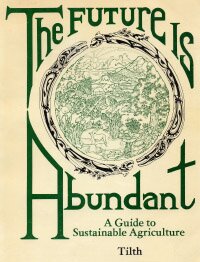
The Future is Abundant
A Guide to Sustainable Agriculture
Tilth Producers of Washington Home | WA Tilth Assoc. | Conference | Directory | Journal | Placement Service | Calendar | Action Alerts
Legislative Update | Bulletin Board | Classifieds | Questions on Agriculture? | Photo Gallery | Links | Contact Us | Join Now | Volunteer

Beekeeping is already an important industry in the Northwest, with over 300,000 hives in Oregon, Washington, Idaho and British Columbia. Although the bloom in some areas is fairly well utilized, there is still room for expansion. Landowners can consciously increase the amount of bee forage on their properties by "beescaping" or planting a carefully selected combination of flowering plants.
The best beescapes are composed of a mixture of farmland, meadows and open woodland which contain an abundance of legumes, herbs, wildflowers, fruits and berries. People who have studied the economics of beescaping say that it is not economically sound to plant farmland to plants whose sole purpose is bee forage. Many of thte best bee plants, however, also have value for other purposes. For example, fruit and berry producing plants are excellent sources of nectar and pollen. Black locust trees are heavy nectar producers and are potentially valuable sources of hardwood. Many culinary and medicinal herbs, such as anise hyssop, borage, thyme, lavender, rosemary, sage (Salvia spp.), lemon balm, catnip, and several other mints are also favored by bees. Many of these herbs have blue flowers, the most effective color for attracting bees.
Bees will range for a two mile radius from the hive. However, since they prefer shorter hauls, production can be much higher if sufficient forage is closer, particularly when the weather is unsettled.
Beescaping requires plant diversity, since bees need to have a succession of bloom throughout the season. Bees begin working early in the spring and continue until the last of the hardy flowers have withered in early winter. Pollen is important throughout the year because it is the food used for rearing brood. Nectar is the source of honey. Some bee plants produce pollen only, while others produce both pollen and nectar.
There are three main periods of bloom to consider in designing beescapes:
Beekeeping can be practiced almost everywhere in the Northwest, but the Interior region is generally more favorable than the Maritime because there are fewer rainy days and because the hotter temperatures induce higher nectar production. There is often a shortage of bloom in the Maritime lowlands during the main nectar production time, so some beekeepers move their bees to the Interior or to the mountains in summer to take advantage of the fireweed, huckleberry, heather and other plants prevalent in clearcut, burnt over and alpine areas.
Tilth Producers of Washington Home | WA Tilth Assoc. | Conference | Directory | Journal | Placement Service | Calendar | Action Alerts
Legislative Update | Bulletin Board | Classifieds | Questions on Agriculture? | Photo Gallery | Links | Contact Us | Join Now | Volunteer